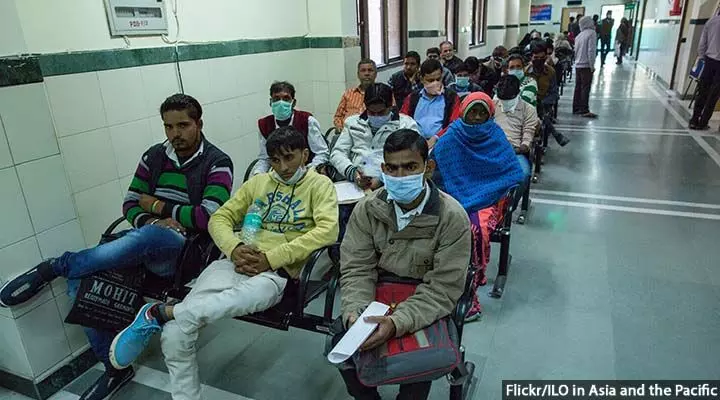Treatment Is Free, Yet 1 In 4 Indian TB Patients Must Sell Assets Or Borrow Money

New Delhi: One in four tuberculosis (TB) patients had to sell assets or borrow money--that is, resort to ‘hardship financing’--to pay for their treatment, a new study has shown.
“The elimination of catastrophic costs by linking eligible TB patients with social welfare schemes including providing nutritional support” is a stated objective of the National Strategic Plan (NSP) 2017-2025, the Centre’s plan to eliminate TB in India by 2025. However, even among those who received free care, 21.3% of patients resorted to hardship financing, according to the study published in the Indian Journal of Tuberculosis in March 2019.
The study used hardship financing as an indicator of the privations a family must undergo to pay for TB treatment. It identified 899 TB cases from the National Sample Survey Office’s (NSSO) 71st round conducted in 2014, which provides information about health expenditure along with various sources of financing. The sources of financing are classified as: own income and savings, borrowings (with or without interest), sale of assets, contributions or assistance from friends and relatives. The authors assumed borrowings, mainly with repayment and interest, similar to a 2015 study published in the journal Health Policy & Planning.
Methodology
Of the various variables associated with a patient such as age, education, sex, marital status, religion and wealth, the researchers first identified the ones that are significant towards out-of-pocket expenditure on outpatient treatment and hospitalisation for TB.
Thereafter, logistic regression was used to describe the data and the relationship of these variables with out-of-pocket expenditure and hardship financing due to TB.
Contextualising out-of-pocket expenditure
While advocating for universal health coverage, the World Health Organization suggests that countries examine out-of-pocket expenditure and poverty to the context of developing countries--to understand the extent to which health expenditure has pushed populations into serious poverty.
Out-of-pocket (OOP) health expenses drove 55 million Indians--more than the population of South Korea, Spain or Kenya--into poverty in 2011-12, and of these, 38 million (69%) were impoverished by expenditure on medicines alone, as IndiaSpend reported on July 19, 2018.
Earlier studies in India (such as here, here and here) have used ‘catastrophic health expenditure’ to measure financial burden of healthcare expenditure on households. Any out-of-pocket expenditure on healthcare is considered catastrophic when it exceeds 10% of the household’s total monthly consumption expenditure or 40% of its monthly non-food consumption expenditure.
Catastrophic health expenditure is difficult to calculate. The measurement involves analysing the percentage of a household (the number of members) exposed to catastrophic health expenditure. Then, a concentration index (CI) is calculated to determine whether poor households incur more catastrophic payments than rich households. A negative value of the CI would indicate a greater tendency for poor households to exceed the thresholds.
As such, the hardship financing model used by the recent study will help estimate out-of-pocket spending. Managers and policymakers of TB control programmes could use the definition of hardship financing to survey TB outpatients and inpatients to understand how such they use and finance expenditure on TB.
Poorest Indians are most affected
Using the NSSO national representative sample, the study estimated that 26.7% of inpatient TB cases and 3.5% of outpatient cases experienced hardship financing. In all, 25.9% patients had to sell assets or use borrowings for financing TB expenses.
The poorest were hit the most, spending 23% of household income on hospitalisation.
| How Indians Financed Their Tuberculosis Treatment | ||||||||||
|---|---|---|---|---|---|---|---|---|---|---|
| Savings | Borrowings | Sale of physical assets | Contributions from Friends | Other sources | ||||||
| Household | Outpatient | Household | Outpatient | Household | Outpatient | Household | Outpatient | Household | Outpatient | |
| Poorest | 50.6 | 97 | 35.1 | 2.6 | 3.9 | - | 10.1 | 0.1 | 0.2 | 0.3 |
| Poorer | 62.6 | 90.3 | 32.2 | 8.3 | 0.5 | - | 4.6 | 0.9 | 0.1 | 0.5 |
| Middle | 68.3 | 98.5 | 30.8 | 0.8 | 0 | - | 0.2 | 0.7 | 0.6 | 0 |
| Richer | 85.1 | 99 | 12 | 1 | 0 | - | 2.9 | 0 | 0 | 0 |
| Richest | 80.9 | 97.4 | 17.6 | 1.8 | 0 | - | 1.5 | 0.8 | 0 | 0.1 |
Source: Author’s calculations based on NSSO 71st Round data
There were no variations among social groups: Among scheduled castes and tribes patients--who account for 34.2% of India’s TB cases--35.2% of inpatient cases sold assets or borrowed money on interest to pay for TB hospitalisation.
India’s TB control programme faces a serious funding crunch: The central government’s allocation of Rs 1,685 crore ($254 million) during 2012-2015 was lower than the minimum commitment of Rs 2,996 crore ($452 million) by India and its partners--a deficit of Rs 631 crore ($95 million). As per the WHO, India contributes only 37% of the total amount required for the TB control programme annually, which is inadequate as compared with other grant-receiving countries for TB.
One of the proposed schemes to address financial and nutritional hardship is to provide cash incentives to every TB patient through direct beneficiary transfer (DBT). Even though the scheme was rolled out in April 2018, of the 2.09 million registered TB patients, 1.2 million (58%) have received cash benefit of Rs 1,000 each for two months. The main reason: many of the rural poor have no bank accounts.
(John is a public health professional and works as an evidence synthesis specialist with the Campbell Collaboration based in New Delhi.)
We welcome feedback. Please write to respond@indiaspend.org. We reserve the right to edit responses for language and grammar.


